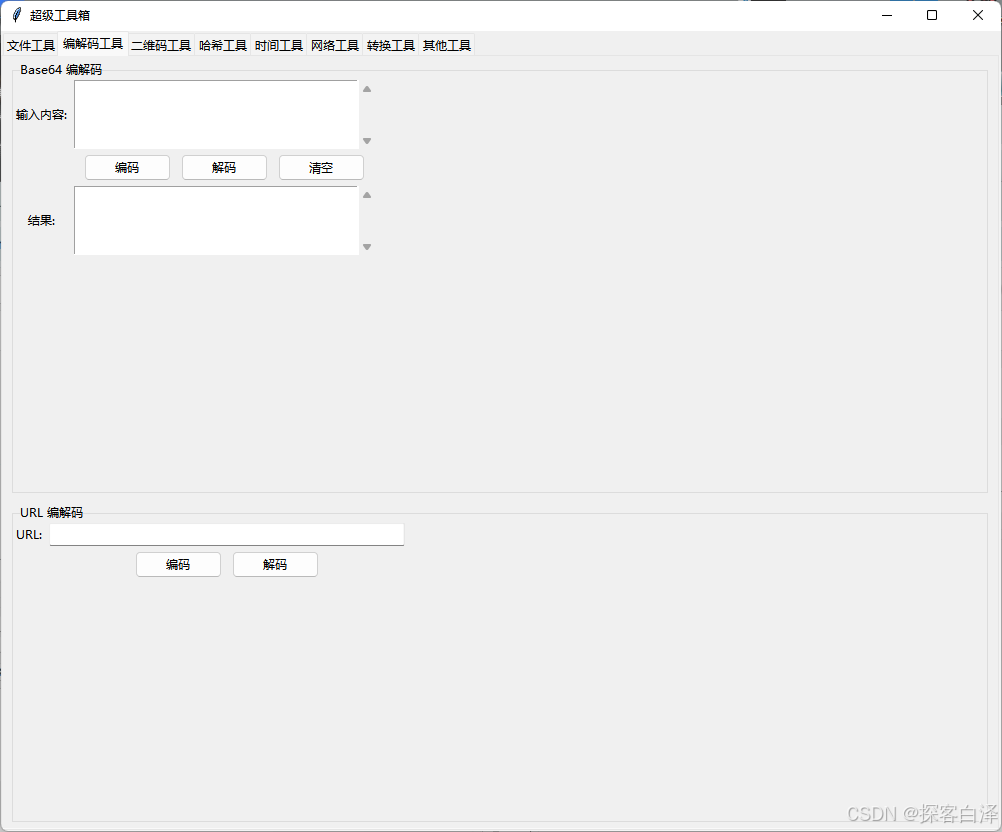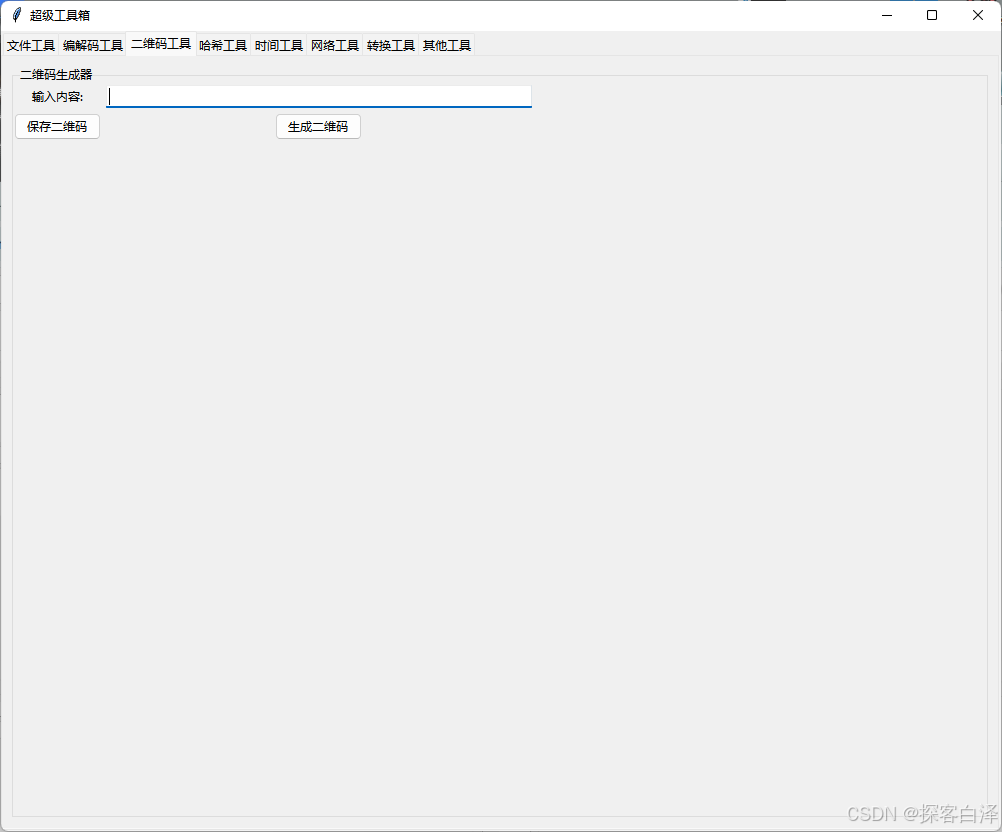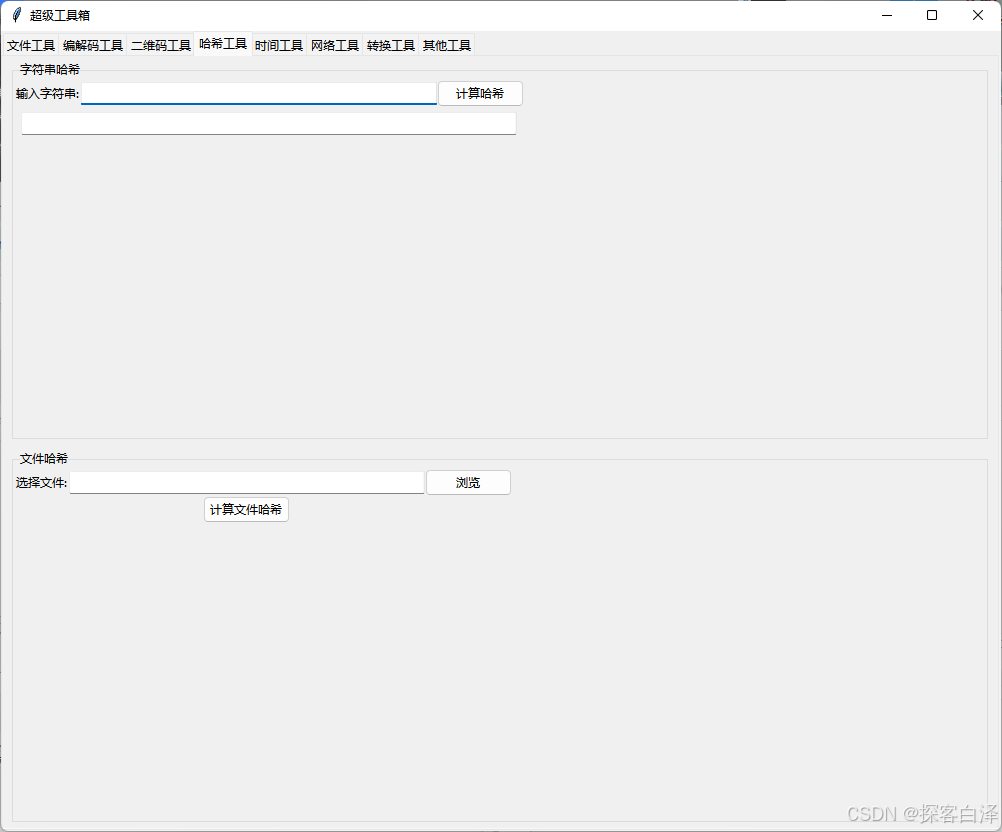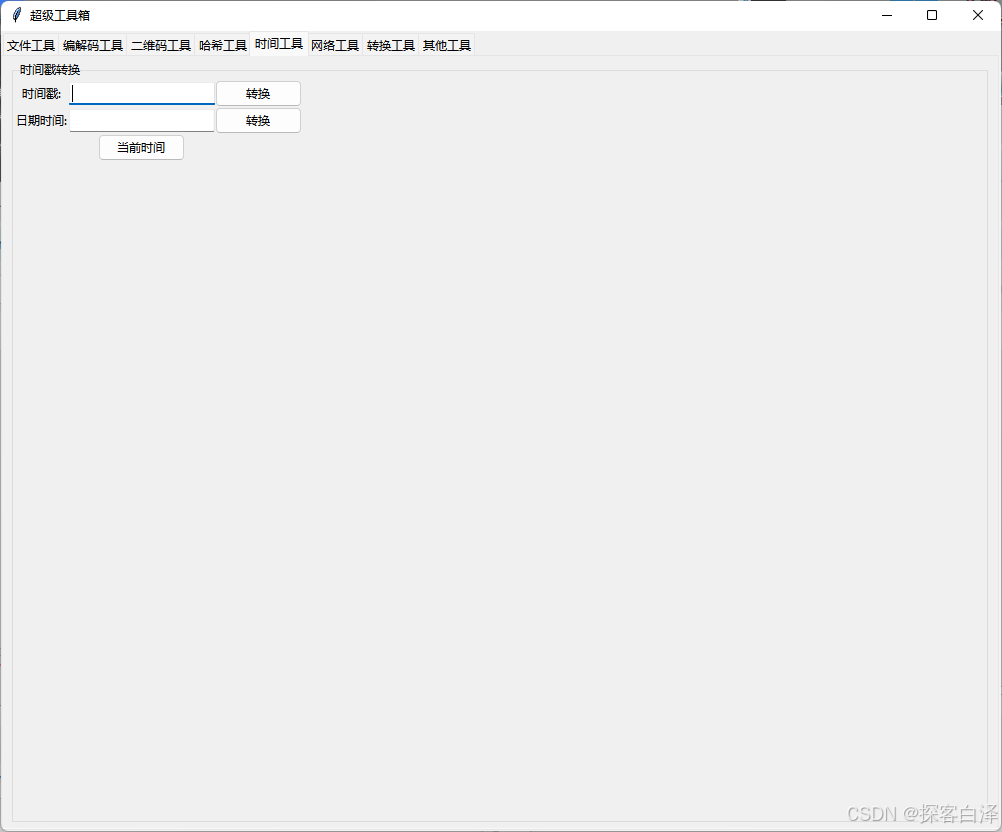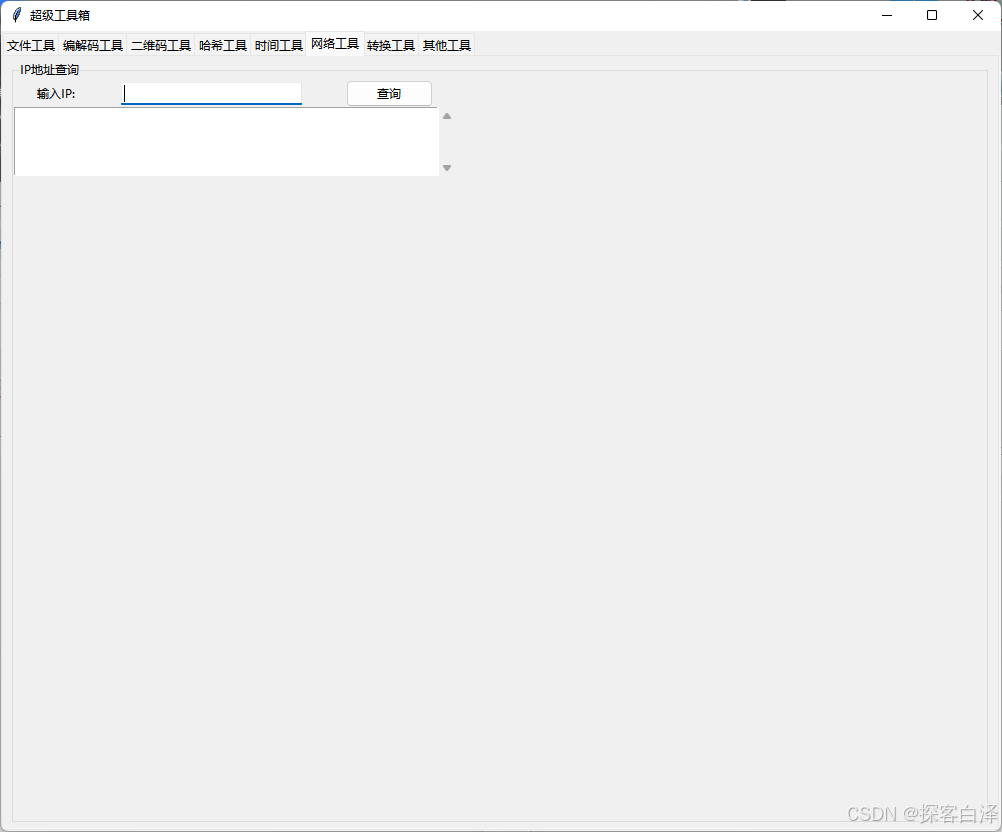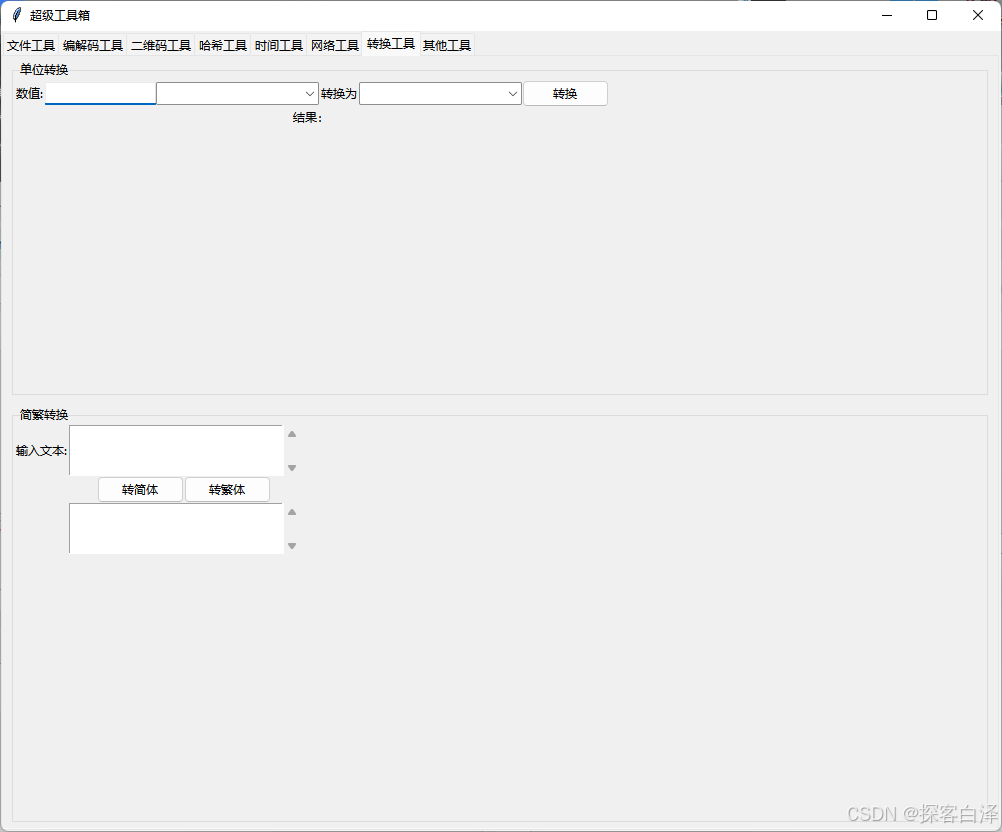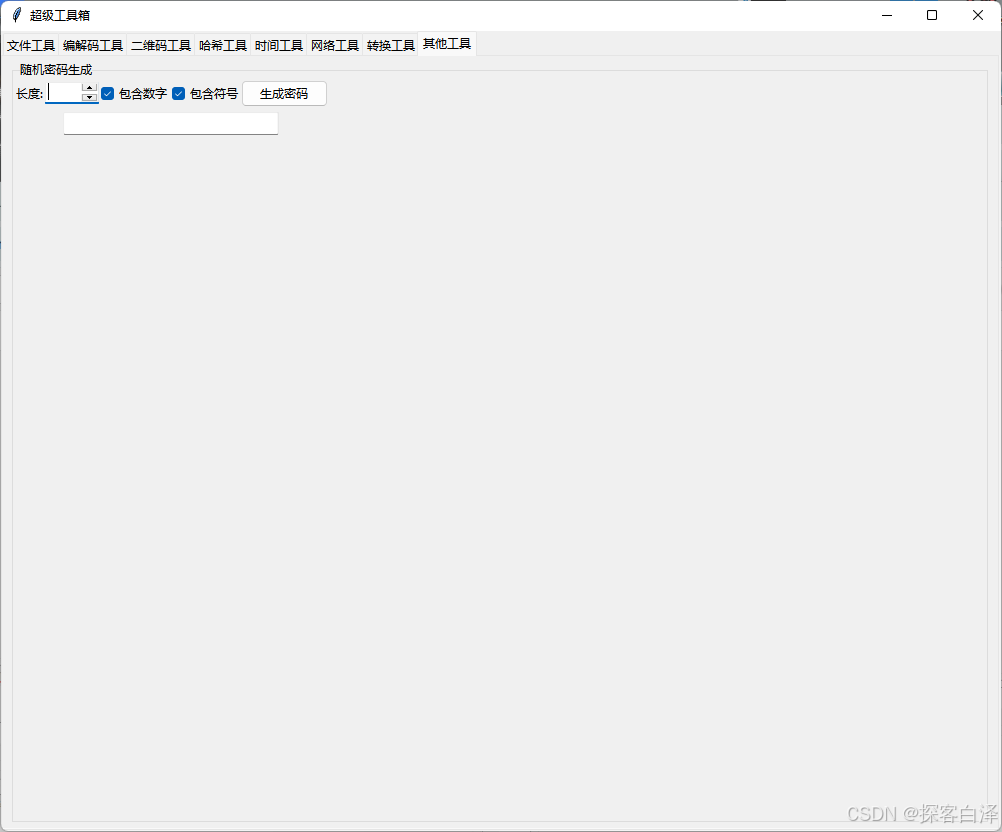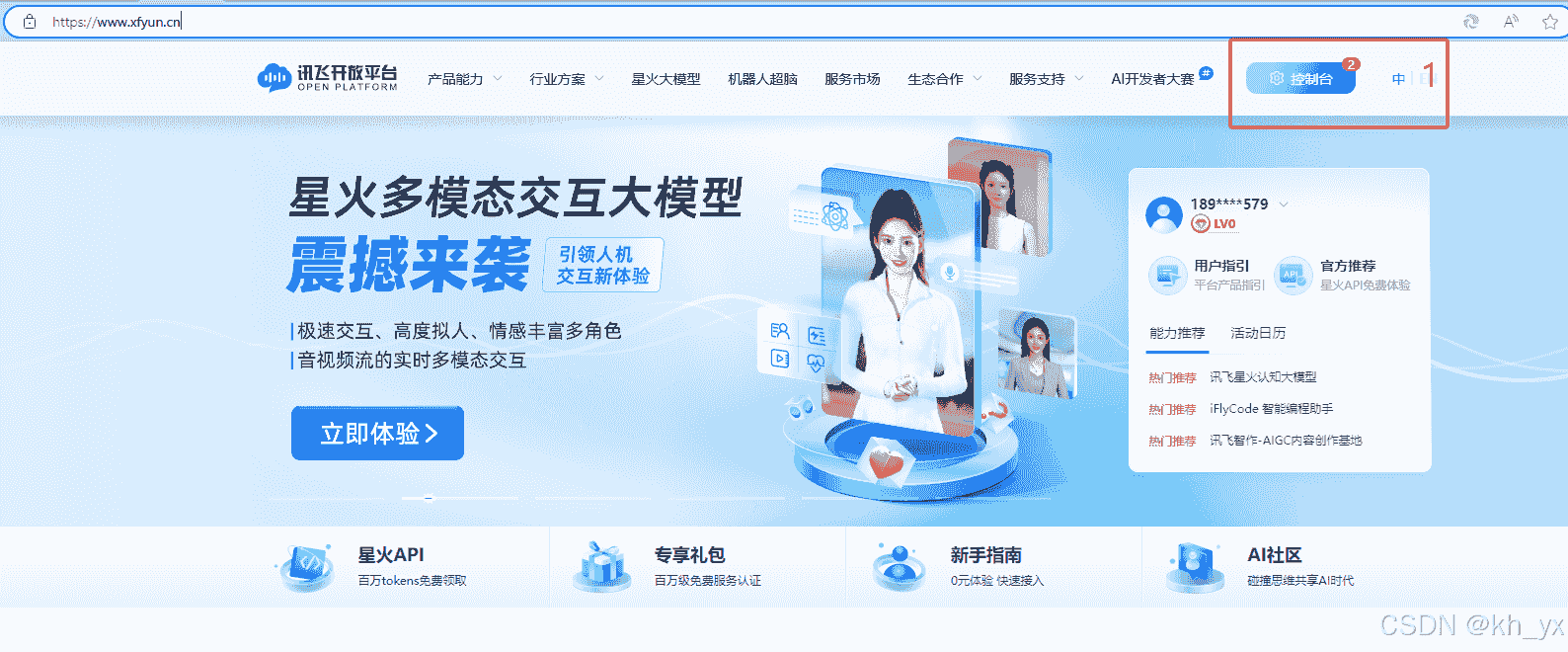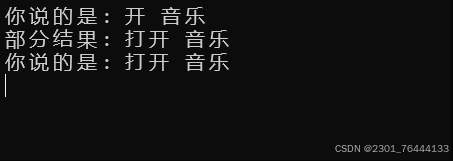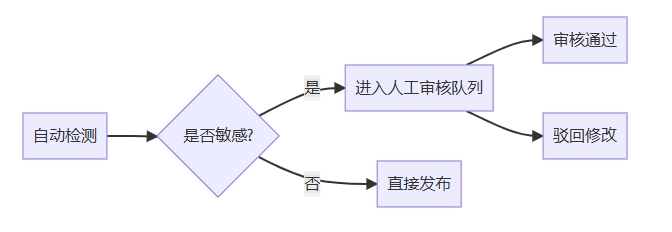|
import tkinter as tk
from tkinter import ttk, filedialog, messagebox
import base64
import hashlib
import os
import qrcode
import webbrowser
import time
import random
import json
import requests
from PIL import Image, ImageTk
from datetime import datetime
from tkinter import scrolledtext
import pyperclip
import zhconv
class ToolBox:
def __init__(self, root):
self.root = root
self.root.title("超级工具箱 v2.0")
self.root.geometry("1000x800")
# 创建标签容器
self.notebook = ttk.Notebook(root)
self.notebook.pack(fill='both', expand=True)
# 创建各个功能标签页
self.create_file_tools_tab()
self.create_encoder_tab()
self.create_qrcode_tab()
self.create_hash_tools_tab()
self.create_time_tools_tab()
self.create_network_tools_tab()
self.create_conversion_tools_tab()
self.create_other_tools_tab()
# 添加右键菜单
self.create_context_menu()
# 右键菜单功能
def create_context_menu(self):
self.context_menu = tk.Menu(self.root, tearoff=0)
self.context_menu.add_command(label="复制", command=self.copy_text)
self.context_menu.add_command(label="粘贴", command=self.paste_text)
# 绑定右键事件
self.root.bind("<Button-3>", self.show_context_menu)
def show_context_menu(self, event):
self.context_menu.post(event.x_root, event.y_root)
def copy_text(self):
widget = self.root.focus_get()
if isinstance(widget, tk.Entry):
widget.event_generate("<<Copy>>")
elif isinstance(widget, tk.Text):
widget.event_generate("<<Copy>>")
def paste_text(self):
widget = self.root.focus_get()
if isinstance(widget, tk.Entry):
widget.event_generate("<<Paste>>")
elif isinstance(widget, tk.Text):
widget.event_generate("<<Paste>>")
# 以下是各功能标签页的创建和功能实现
def create_file_tools_tab(self):
tab = ttk.Frame(self.notebook)
self.notebook.add(tab, text="文件工具")
# 文件搜索功能
search_frame = ttk.LabelFrame(tab, text="文件搜索")
search_frame.pack(padx=10, pady=5, fill='both', expand=True)
ttk.Label(search_frame, text="搜索目录:").grid(row=0, column=0, sticky='w')
self.path_entry = ttk.Entry(search_frame, width=50)
self.path_entry.grid(row=0, column=1, padx=5)
ttk.Button(search_frame, text="选择目录", command=self.browse_directory).grid(row=0, column=2)
ttk.Label(search_frame, text="关键词:").grid(row=1, column=0, sticky='w')
self.keyword_entry = ttk.Entry(search_frame, width=50)
self.keyword_entry.grid(row=1, column=1, pady=5)
ttk.Button(search_frame, text="开始搜索", command=self.search_files).grid(row=2, column=1, pady=10)
self.result_text = scrolledtext.ScrolledText(search_frame, height=10, width=80)
self.result_text.grid(row=3, column=0, columnspan=3)
# 文件批量重命名
rename_frame = ttk.LabelFrame(tab, text="批量重命名")
rename_frame.pack(padx=10, pady=5, fill='both', expand=True)
ttk.Label(rename_frame, text="原文件名:").grid(row=0, column=0)
self.original_name = ttk.Entry(rename_frame, width=25)
self.original_name.grid(row=0, column=1)
ttk.Label(rename_frame, text="新文件名:").grid(row=0, column=2)
self.new_name = ttk.Entry(rename_frame, width=25)
self.new_name.grid(row=0, column=3)
ttk.Button(rename_frame, text="执行重命名", command=self.batch_rename).grid(row=0, column=4, padx=10)
def create_encoder_tab(self):
tab = ttk.Frame(self.notebook)
self.notebook.add(tab, text="编解码工具")
# Base64 编解码
base64_frame = ttk.LabelFrame(tab, text="Base64 编解码")
base64_frame.pack(padx=10, pady=5, fill='both', expand=True)
ttk.Label(base64_frame, text="输入内容:").grid(row=0, column=0)
self.base64_input = scrolledtext.ScrolledText(base64_frame, height=5, width=40)
self.base64_input.grid(row=0, column=1, padx=5)
btn_frame = ttk.Frame(base64_frame)
btn_frame.grid(row=1, column=1, pady=5)
ttk.Button(btn_frame, text="编码", command=self.base64_encode).pack(side='left', padx=5)
ttk.Button(btn_frame, text="解码", command=self.base64_decode).pack(side='left', padx=5)
ttk.Button(btn_frame, text="清空", command=self.clear_base64).pack(side='right', padx=5)
ttk.Label(base64_frame, text="结果:").grid(row=2, column=0)
self.base64_output = scrolledtext.ScrolledText(base64_frame, height=5, width=40)
self.base64_output.grid(row=2, column=1, padx=5)
# URL 编解码
url_frame = ttk.LabelFrame(tab, text="URL 编解码")
url_frame.pack(padx=10, pady=5, fill='both', expand=True)
ttk.Label(url_frame, text="URL:").grid(row=0, column=0)
self.url_entry = ttk.Entry(url_frame, width=50)
self.url_entry.grid(row=0, column=1, padx=5)
btn_frame = ttk.Frame(url_frame)
btn_frame.grid(row=1, column=1, pady=5)
ttk.Button(btn_frame, text="编码", command=self.url_encode).pack(side='left', padx=5)
ttk.Button(btn_frame, text="解码", command=self.url_decode).pack(side='left', padx=5)
def create_qrcode_tab(self):
tab = ttk.Frame(self.notebook)
self.notebook.add(tab, text="二维码工具")
frame = ttk.LabelFrame(tab, text="二维码生成器")
frame.pack(padx=10, pady=10, fill='both', expand=True)
ttk.Label(frame, text="输入内容:").grid(row=0, column=0)
self.qr_content = ttk.Entry(frame, width=60)
self.qr_content.grid(row=0, column=1, padx=5)
ttk.Button(frame, text="生成二维码", command=self.generate_qrcode).grid(row=1, column=1, pady=5)
ttk.Button(frame, text="保存二维码", command=self.save_qrcode).grid(row=1, column=0, pady=5)
self.qr_image_label = ttk.Label(frame)
self.qr_image_label.grid(row=2, column=0, columnspan=2)
def create_hash_tools_tab(self):
tab = ttk.Frame(self.notebook)
self.notebook.add(tab, text="哈希工具")
# 字符串哈希
str_frame = ttk.LabelFrame(tab, text="字符串哈希")
str_frame.pack(padx=10, pady=5, fill='both', expand=True)
ttk.Label(str_frame, text="输入字符串:").grid(row=0, column=0)
self.hash_input = ttk.Entry(str_frame, width=50)
self.hash_input.grid(row=0, column=1)
ttk.Button(str_frame, text="计算哈希", command=self.calculate_str_hash).grid(row=0, column=2)
self.hash_result = ttk.Entry(str_frame, width=70)
self.hash_result.grid(row=1, column=0, columnspan=3, pady=5)
# 文件哈希
file_frame = ttk.LabelFrame(tab, text="文件哈希")
file_frame.pack(padx=10, pady=5, fill='both', expand=True)
ttk.Label(file_frame, text="选择文件:").grid(row=0, column=0)
self.file_hash_entry = ttk.Entry(file_frame, width=50)
self.file_hash_entry.grid(row=0, column=1)
ttk.Button(file_frame, text="浏览", command=self.browse_hash_file).grid(row=0, column=2)
ttk.Button(file_frame, text="计算文件哈希", command=self.calculate_file_hash).grid(row=1, column=1)
def create_time_tools_tab(self):
tab = ttk.Frame(self.notebook)
self.notebook.add(tab, text="时间工具")
# 时间戳转换
ts_frame = ttk.LabelFrame(tab, text="时间戳转换")
ts_frame.pack(padx=10, pady=5, fill='both', expand=True)
ttk.Label(ts_frame, text="时间戳:").grid(row=0, column=0)
self.timestamp_entry = ttk.Entry(ts_frame)
self.timestamp_entry.grid(row=0, column=1)
ttk.Button(ts_frame, text="转换", command=self.timestamp_to_datetime).grid(row=0, column=2)
ttk.Label(ts_frame, text="日期时间:").grid(row=1, column=0)
self.datetime_entry = ttk.Entry(ts_frame)
self.datetime_entry.grid(row=1, column=1)
ttk.Button(ts_frame, text="转换", command=self.datetime_to_timestamp).grid(row=1, column=2)
ttk.Button(ts_frame, text="当前时间", command=self.get_current_time).grid(row=2, column=1)
def create_network_tools_tab(self):
tab = ttk.Frame(self.notebook)
self.notebook.add(tab, text="网络工具")
# IP查询
ip_frame = ttk.LabelFrame(tab, text="IP地址查询")
ip_frame.pack(padx=10, pady=5, fill='both', expand=True)
ttk.Label(ip_frame, text="输入IP:").grid(row=0, column=0)
self.ip_entry = ttk.Entry(ip_frame, width=25)
self.ip_entry.grid(row=0, column=1)
ttk.Button(ip_frame, text="查询", command=self.ip_lookup).grid(row=0, column=2)
self.ip_result = scrolledtext.ScrolledText(ip_frame, height=5, width=60)
self.ip_result.grid(row=1, column=0, columnspan=3)
def create_conversion_tools_tab(self):
tab = ttk.Frame(self.notebook)
self.notebook.add(tab, text="转换工具")
# 单位转换
unit_frame = ttk.LabelFrame(tab, text="单位转换")
unit_frame.pack(padx=10, pady=5, fill='both', expand=True)
ttk.Label(unit_frame, text="数值:").grid(row=0, column=0)
self.num_entry = ttk.Entry(unit_frame, width=15)
self.num_entry.grid(row=0, column=1)
self.unit_from = ttk.Combobox(unit_frame, values=["米", "千米", "英尺"])
self.unit_from.grid(row=0, column=2)
ttk.Label(unit_frame, text="转换为").grid(row=0, column=3)
self.unit_to = ttk.Combobox(unit_frame, values=["米", "千米", "英尺"])
self.unit_to.grid(row=0, column=4)
ttk.Button(unit_frame, text="转换", command=self.unit_convert).grid(row=0, column=5)
self.unit_result = ttk.Label(unit_frame, text="结果:")
self.unit_result.grid(row=1, column=0, columnspan=6)
# 简繁转换
zh_frame = ttk.LabelFrame(tab, text="简繁转换")
zh_frame.pack(padx=10, pady=5, fill='both', expand=True)
ttk.Label(zh_frame, text="输入文本:").grid(row=0, column=0)
self.zh_input = scrolledtext.ScrolledText(zh_frame, height=3, width=30)
self.zh_input.grid(row=0, column=1)
btn_frame = ttk.Frame(zh_frame)
btn_frame.grid(row=1, column=1)
ttk.Button(btn_frame, text="转简体", command=lambda: self.convert_zh('zh-cn')).pack(side='left')
ttk.Button(btn_frame, text="转繁体", command=lambda: self.convert_zh('zh-tw')).pack(side='left')
self.zh_output = scrolledtext.ScrolledText(zh_frame, height=3, width=30)
self.zh_output.grid(row=2, column=1)
def create_other_tools_tab(self):
tab = ttk.Frame(self.notebook)
self.notebook.add(tab, text="其他工具")
# 密码生成器
pwd_frame = ttk.LabelFrame(tab, text="随机密码生成")
pwd_frame.pack(padx=10, pady=5, fill='both', expand=True)
ttk.Label(pwd_frame, text="长度:").grid(row=0, column=0)
self.pwd_length = ttk.Spinbox(pwd_frame, from_=6, to=32, width=5)
self.pwd_length.grid(row=0, column=1)
self.use_digits = tk.BooleanVar(value=True)
ttk.Checkbutton(pwd_frame, text="包含数字", variable=self.use_digits).grid(row=0, column=2)
self.use_symbols = tk.BooleanVar(value=True)
ttk.Checkbutton(pwd_frame, text="包含符号", variable=self.use_symbols).grid(row=0, column=3)
ttk.Button(pwd_frame, text="生成密码", command=self.generate_password).grid(row=0, column=4)
self.password_entry = ttk.Entry(pwd_frame, width=30)
self.password_entry.grid(row=1, column=0, columnspan=5, pady=5)
# 以下是各功能的实现方法
def browse_directory(self):
path = filedialog.askdirectory()
self.path_entry.delete(0, tk.END)
self.path_entry.insert(0, path)
def search_files(self):
directory = self.path_entry.get()
keyword = self.keyword_entry.get()
if not directory or not keyword:
messagebox.showwarning("提示", "请先选择目录并输入关键词")
return
self.result_text.delete(1.0, tk.END)
count = 0
for root, dirs, files in os.walk(directory):
for file in files:
if keyword.lower() in file.lower():
filepath = os.path.join(root, file)
self.result_text.insert(tk.END, filepath + "\n")
count += 1
self.result_text.insert(tk.END, f"\n找到 {count} 个匹配文件")
def batch_rename(self):
original = self.original_name.get()
new = self.new_name.get()
directory = self.path_entry.get()
if not directory:
messagebox.showwarning("提示", "请先选择目录")
return
count = 0
for filename in os.listdir(directory):
if original in filename:
new_filename = filename.replace(original, new)
os.rename(
os.path.join(directory, filename),
os.path.join(directory, new_filename)
)
count += 1
messagebox.showinfo("完成", f"成功重命名 {count} 个文件")
def base64_encode(self):
text = self.base64_input.get("1.0", tk.END).strip()
encoded = base64.b64encode(text.encode()).decode()
self.base64_output.delete("1.0", tk.END)
self.base64_output.insert(tk.END, encoded)
def base64_decode(self):
text = self.base64_input.get("1.0", tk.END).strip()
try:
decoded = base64.b64decode(text).decode()
self.base64_output.delete("1.0", tk.END)
self.base64_output.insert(tk.END, decoded)
except:
messagebox.showerror("错误", "解码失败,请检查输入内容")
def clear_base64(self):
self.base64_input.delete("1.0", tk.END)
self.base64_output.delete("1.0", tk.END)
def url_encode(self):
text = self.url_entry.get()
encoded = requests.utils.quote(text)
self.url_entry.delete(0, tk.END)
self.url_entry.insert(0, encoded)
def url_decode(self):
text = self.url_entry.get()
decoded = requests.utils.unquote(text)
self.url_entry.delete(0, tk.END)
self.url_entry.insert(0, decoded)
def generate_qrcode(self):
data = self.qr_content.get()
if not data:
return
qr = qrcode.QRCode(
version=1,
error_correction=qrcode.constants.ERROR_CORRECT_L,
box_size=10,
border=4,
)
qr.add_data(data)
qr.make(fit=True)
self.qr_img = qr.make_image(fill_color="black", back_color="white")
self.display_qrcode()
def display_qrcode(self):
self.qr_img.save("temp_qr.png")
image = Image.open("temp_qr.png")
image.thumbnail((300, 300))
photo = ImageTk.PhotoImage(image)
self.qr_image_label.config(image=photo)
self.qr_image_label.image = photo
def save_qrcode(self):
if hasattr(self, 'qr_img'):
filename = filedialog.asksaveasfilename(
defaultextension=".png",
filetypes=[("PNG文件", "*.png"), ("所有文件", "*.*")]
)
if filename:
self.qr_img.save(filename)
messagebox.showinfo("保存成功", "二维码已保存")
def calculate_str_hash(self):
text = self.hash_input.get()
algorithms = ['md5', 'sha1', 'sha256']
results = []
for algo in algorithms:
hash_obj = hashlib.new(algo)
hash_obj.update(text.encode())
results.append(f"{algo.upper()}: {hash_obj.hexdigest()}")
self.hash_result.delete(0, tk.END)
self.hash_result.insert(0, " | ".join(results))
def browse_hash_file(self):
filename = filedialog.askopenfilename()
self.file_hash_entry.delete(0, tk.END)
self.file_hash_entry.insert(0, filename)
def calculate_file_hash(self):
filename = self.file_hash_entry.get()
if not os.path.isfile(filename):
return
hash_md5 = hashlib.md5()
with open(filename, "rb") as f:
for chunk in iter(lambda: f.read(4096), b""):
hash_md5.update(chunk)
self.hash_result.delete(0, tk.END)
self.hash_result.insert(0, f"MD5: {hash_md5.hexdigest()}")
def timestamp_to_datetime(self):
try:
ts = int(self.timestamp_entry.get())
dt = datetime.fromtimestamp(ts).strftime('%Y-%m-%d %H:%M:%S')
self.datetime_entry.delete(0, tk.END)
self.datetime_entry.insert(0, dt)
except:
messagebox.showerror("错误", "无效的时间戳")
def datetime_to_timestamp(self):
try:
dt_str = self.datetime_entry.get()
dt = datetime.strptime(dt_str, '%Y-%m-%d %H:%M:%S')
ts = int(dt.timestamp())
self.timestamp_entry.delete(0, tk.END)
self.timestamp_entry.insert(0, ts)
except:
messagebox.showerror("错误", "无效的日期格式")
def get_current_time(self):
current_ts = int(time.time())
current_dt = datetime.now().strftime('%Y-%m-%d %H:%M:%S')
self.timestamp_entry.delete(0, tk.END)
self.timestamp_entry.insert(0, current_ts)
self.datetime_entry.delete(0, tk.END)
self.datetime_entry.insert(0, current_dt)
def ip_lookup(self):
ip = self.ip_entry.get()
try:
response = requests.get(f"http://ip-api.com/json/{ip}")
data = response.json()
result = f"""
国家: {data.get('country', '未知')}
地区: {data.get('regionName', '未知')}
城市: {data.get('city', '未知')}
ISP: {data.get('isp', '未知')}
AS: {data.get('as', '未知')}
"""
self.ip_result.delete(1.0, tk.END)
self.ip_result.insert(tk.END, result)
except:
messagebox.showerror("错误", "查询失败")
def unit_convert(self):
try:
value = float(self.num_entry.get())
unit_from = self.unit_from.get()
unit_to = self.unit_to.get()
# 转换系数(米为基准单位)
units = {
"米": 1,
"千米": 1000,
"英尺": 0.3048
}
result = value * units[unit_from] / units[unit_to]
self.unit_result.config(text=f"结果: {result:.4f} {unit_to}")
except:
messagebox.showerror("错误", "无效的输入")
def convert_zh(self, target):
text = self.zh_input.get("1.0", tk.END)
converted = zhconv.convert(text, target)
self.zh_output.delete("1.0", tk.END)
self.zh_output.insert(tk.END, converted)
def generate_password(self):
length = int(self.pwd_length.get())
chars = 'abcdefghijklmnopqrstuvwxyzABCDEFGHIJKLMNOPQRSTUVWXYZ'
if self.use_digits.get():
chars += '0123456789'
if self.use_symbols.get():
chars += '!@#$%^&*()_+-='
password = ''.join(random.choice(chars) for _ in range(length))
self.password_entry.delete(0, tk.END)
self.password_entry.insert(0, password)
pyperclip.copy(password)
messagebox.showinfo("提示", "密码已复制到剪贴板")
if __name__ == "__main__":
root = tk.Tk()
app = ToolBox(root)
root.mainloop()
|




